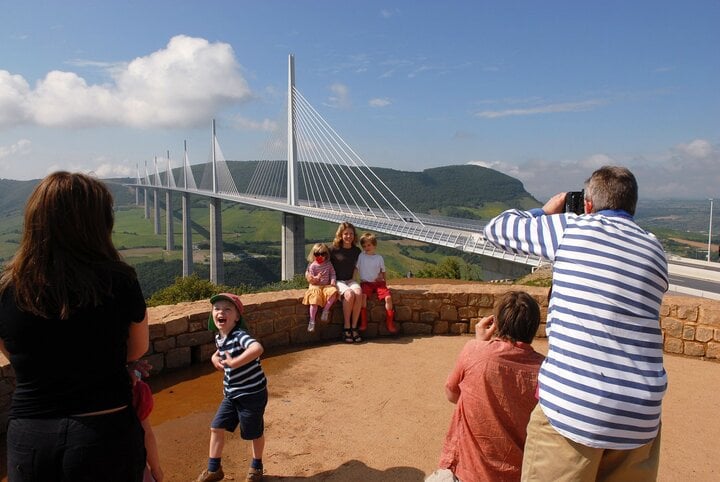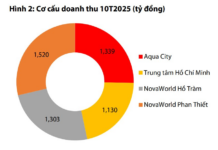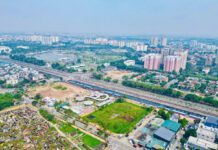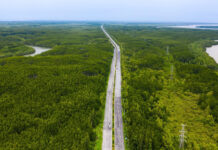The Millau Viaduct, Shrouded in Fog and Soaring Above the Clouds
Often shrouded in mist, giving the sensation of driving through the clouds, the Millau Viaduct is so famous that it has its own dedicated visitor center. The bridge is even visible from space.
The Millau Viaduct, a perfect example of architecture and engineering, spans the Tarn River Valley in Millau, Aveyron, southern France. The bridge was designed by British architect Norman Foster and French bridge engineer Michel Virlogeux.

The Millau Viaduct, designed by engineer Michel Virlogeux and architect Norman Foster. (Photo: Sergi Reboredo)
At one time, it was considered the tallest bridge in the world at an estimated height of 336.4 meters, and it still holds the record for the tallest bridge pillar in the world. However, even these impressive statistics fail to capture the true beauty of the bridge.
Unlike other famous bridges, which typically connect two points of similar elevation, the Millau Viaduct is like a roller coaster, gliding along a flat path across the Tarn River Valley. Seven bridge piers range in height from 78 to 245 meters, each precisely calculated to the millimeter to create a seamless driving experience as one glides through the valley. There is a span of 342 meters between each pair of piers, large enough for the Eiffel Tower to fit through.
The piers are connected by seven steel columns, each 87 meters high, with 11 suspension cables fanning out on both sides. All of this helps to keep the roadway stable. The bridge is considered an engineering marvel of absolute precision while also providing a beautiful vista for the Gorges du Tarn region.
David Knight, Design and Engineering Director at Cake Industries, calls it a “wonder of the modern world” and an “engineering marvel.”
“The perfect combination of architecture and engineering means that anyone who sees the bridge will think it’s a spectacular structure,” Knight added.

The Millau Viaduct was built to alleviate the notorious traffic congestion in the area. (Photo: Google Earth)
Whether viewed from the valley below, where it inspires awe, or from the driver’s seat as one glides through its gentle curves and natural landscape, it’s no wonder that for many, driving across the Millau Viaduct is a bucket list experience.
Michel Virlogeux, the engineer who led the design team from 1987, said it took two decades to plan the construction of the bridge.
The Massif Central is a vast plateau in central and southern France. It is one of the largest geological areas in Europe, covering more than 15% of French territory.
In ancient times, the Massif Central was a remote and inaccessible region. Travel was primarily by single-track railway. The central region of France was unable to develop due to poor transportation infrastructure.
In the 1980s, the French government decided to upgrade the road network. One of the goals was to alleviate the notorious traffic congestion around Millau. Each day, there would be a 20-kilometer-long traffic jam on both sides of the town.
“Millau used to be a traffic nightmare for tourists. There were frequent traffic jams, with long lines of cars stuck in traffic. It gave a very bad image of our region. The pollution was terrible, and it took locals a long time to get from one place to another,” said Emmanuelle Gazel, the current mayor of Millau.
Norman Foster, the architect who designed the bridge, described the area as “a valley of great beauty but which had become one of the worst bottlenecks in France.”
The decision to build a bridge near Millau was made in September 1986. The project brought together experts in geology, geotechnical engineering, road engineering, and engineer Virlogeux, who had worked on the Pont de Normandie, a 2,143-meter-long bridge over the Seine River in Normandy.
Given the situation, engineer Virlogeux understood that a suspension bridge would be the best option. “Cables would be the most efficient structure to carry the loads, and a central thin deck would be added to the structure,” he explained.
The French government held a design competition in 1996, which was won by Virlogeux as the engineer and Norman Foster as the architect.

The Millau Viaduct remains a popular destination for travelers passing through the Millau region. (Photo: Sergi Reboredo)
Architect Foster described their plan to cross the valley instead of the river as a “philosophical concept” that led to a unique bridge design, unlike any previous project.
The design featured seven elegant piers stretching across the landscape, with Foster describing the roadway as “incredibly thin, like a razor blade,” a description that has stood the test of time.
While the viaduct may have been controversial when it was first proposed, the concerns of the local residents faded as they came to understand the project’s significance. Notably, traveling from northern to southern France and from Northern Europe to Spain (or vice versa) became a much smoother experience.
Architect Foster said he was “delighted” by the change in the locals’ mindset. The bridge became not just a connector of two plateaus but also a unifier of people.
Today, as it approaches its 20th anniversary, the Millau Viaduct remains a popular destination for travelers and a marvel of modern engineering.








































